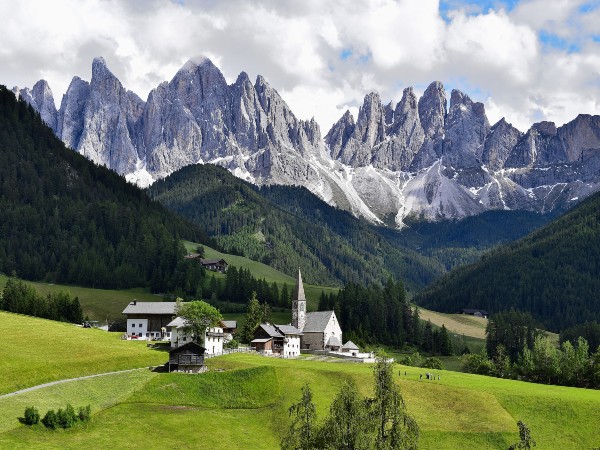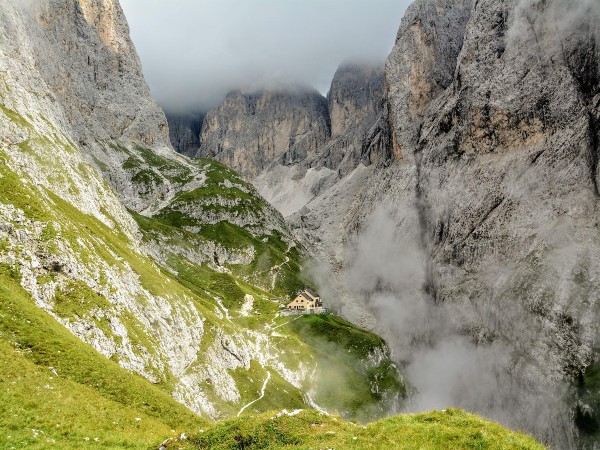Carved by glaciers and fretted by frost, the extraordinary rock skyline of the dolomites looks like vast battlements, needles, towers and walls. This mountain range in northeast Italy is a series of light-coloured limestone ridges separated by green valleys, and rivalling each other in their spectacular shapes.
They started life as coral reefs submerged in shallow seas and were thrust upwards, with the rest of the Alps, some 65 million years ago.


Legend tells that these Monti Pallidi, as they were originally called, acquired their pale rock faces when gnomes, anxious to please a homesick Moon Princess who had married an Alpine Prince, draped them in a gossamer mantle woven from moonbeams.
When the french geologist Deodat de Dolomieu examined the rock in the 1780's he discovered that it contained small amounts of Magnesium. This distinctive limestone has since been known as dolomite in recognition of his discovery. In daylight, it ranges in colour from pale to grey to near-white, but at sunset, the massive rock faces are often batched in shades of orange and pink.

In winter the bare rock peaks rise dramatically from the snow-covered slopes. But with the arrival of spring, a gentler scene is revealed; flower-filled meadow swathe the upper slopes, and rock crevices shelter clumps of gem-like alpines such as saxifrage, edelweiss and pasqueflowers. Lower down, songbirds nest in the woods, and along the valley floors, farmers busy themselves in orchards and pastures. A network of paths snakes along the lower slopes, and higher up long-distance trails crest the ridges, providing exhilarating views for experienced walkers.
At the heart of the Dolomites are the Alpe di Siusi, the Cantinacco ranges and glacier-topped Marmolada. Crowned with a 330ft (100m) pyramid of rock; Marmolada is the undisputed Queen of the Dolomites, her southern face a sheer cliff 2000ft (600m) high. The plateaus of the Ape di Siusi are a wonderland of brightly coloured and fragrant meadows, enclosed by soaring dolomite spires. The massive walls of Catinaccio, which glow red in the rising and setting sun, rise sheer where once the rose garden of Lauren, King of the Dwarfs, is said to have flourished.

Because of the region's chequered history, many places retain both Italian and Austrian names - Catinaccio is also known as Rosengarten. The Dolomites were under Roman rule for centuries, then in the 14th century became part of the Habsburg Empire. After World War I, they were returned to Italy.
South of Marmolada, the bare peaks of Pale de San Martin preside over the tranquil forests of Paneveggio National Park which once furnished the Venetians with timber for their ships.
Isolated from the other ranges but sharing the same dolomite rock are the battlemented peaks of the Brenta to the west. These rugged pinnacles were scaled in the 19th century by British pioneer climbers, among them Francis Fox Tuckett. With only a ladder and a stout stick, he carved out a new route 'amongst toppling rocks, and spires of white and brown and bronze'. At the summit, he rewarded himself with a joint of meat and a draught of red wine. Today, Brenta's crags are still among the most challenging in the Dolomites.



 Click it and Unblock the Notifications
Click it and Unblock the Notifications























